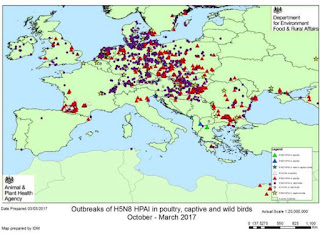#12,302
Our last detailed update on HPAI H5 in Europe came 10 days ago from France (see ESA: Epidemiological Update On H5N8/H5N5 In Europe - Feb 28th). Today it is DEFRA's turn, with the publication of their 12th Outbreak Assessment (complete list here).
Due to its length I've limited excerpts to the Situation Assessment and Conclusions. Details on the UK's recent outbreaks and detections in wild birds are contained in the first section (Disease report).
Follow the link to read the full report.
Department for Environment, Food and Rural Affairs
Animal & Plant Health Agency
Veterinary & Science Policy Advice Team - International Disease Monitoring
Updated Outbreak Assessment number 12 Highly Pathogenic Avian Influenza H5N8 in the UKand Europe
8th March 2017 Ref: VITT/1200 Avian Influenza in UK & Europe
Situation assessment
The situation in Europe has continued with wild bird findings and cases in poultry or captive birds still being reported. Lithuania has now reported findings in wild birds while Spain has reported an outbreak in domestic poultry for the first time in this epizootic. There have been over 900 outbreaks in poultry and over 40 in captive birds reported now to the EU ADNS system (which may include non-EU countries) and a small number of H5N5 reports and each day more reports are made, particularly for wild bird findings.
Austria has reported H5N5 HPAI in a wild bird, which makes it the 8th country in Europe to report H5N5. While Greece has reported H5N6 HPAI in backyard poultry – initial data on this virus suggests it is not related to the H5N6 virus which is currently being reported in Asia and which has caused few human infections. Further sequencing will be carried out in the EURL at Weybridge for any more information. This is the first report of H5N6 HPAI this season in Europe.
As a result of the continuing reporting in the EU, the risk level for the UK is maintained at “HIGH” for an incursion of an infected wild bird, and as “LOW TO MEDIUM” for introduction of infection to poultry on individual premises dependent on the level of on farm biosecurity. Commercial poultry premises with good or high biosecurity measures are unlikely to get disease. The widespread locations of the positive wild bird findings suggest that we should consider the whole of the UK as a risk area for wild bird infection but that areas with populations of waterfowl species may carry a greater risk proportionally in terms of risk level for poultry premises.
As a result of the increase in positive findings in wild birds in Europe, we ask that the public use the Defra helpline (Tel: 03459 33 55 77) to report findings of dead wild birds. In particular, any wild ducks, wild geese, swans, gulls or birds of prey and where more than five birds of any species are found dead in the same location.
Further information is available here: https://www.gov.uk/guidance/avian-influenza-bird-flu including updated biosecurity advice for poultry keepers which they should take note of:
https://www.gov.uk/guidance/avian-influenza-bird-flu#prevention-zone
Conclusion
We continue to consider the risk level is high for further introductions via wild birds, but the risk of entry into poultry farms remains as low to medium depending on the level of biosecurity.
We would like to remind all poultry keepers that the clinical signs of this virus are variable and will depend on the species, but any suspicion of production drop, increased mortality, sick and depressed birds with a temperature and neurological signs should be initially discussed with their private veterinarian.
We will continue to report on the situation
